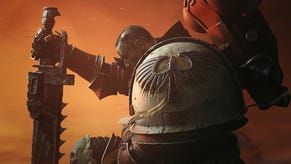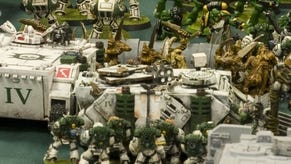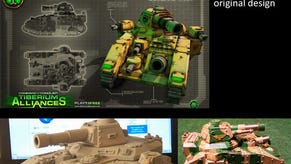Warhammer 40,000: Dawn of War II
Hail bonding.
"Alcoholism's a strong word... but we're a rowdy studio," says Dawn of War II's charismatic lead designer Jonny Ebbert, who has just been telling us about how a fifth of them got thrown out of their own Christmas party, and how when they're not being manhandled by bouncers they like to "knock each other out or smash stuff; all kinds of crazy shit". Alright then.
As amusing as it is to hear developers go off-script, it's key to understanding the bullish Canadian developer. The team works hard, plays hard and trusts in one another. And, as a group, exudes confidence in what it is creating.
This is important for Dawn of War II, full sequel to the 2004 Warhammer 40,000-themed action-RTS, as it provides the team with the creative security to reject a bunch of the generic conventions it has slavishly adhered to in the studio's 11-year existence; to remould the RTS as an accessible, inclusive experience, and not just an impenetrable dark art lorded by swivel-eyed hunchbacks with 17 fingers and a PhD in Qwerty. Oli's already covered Relic's bleak account of the state of the genre and plans to give it a good kick up the RTS. Inside the developer's offices in Vancouver, it's time to put these claims to the test.
"PC has been in a bit of a rut; we've done it to ourselves," admits Ebbert, reviving the theme. "We've made it way too freaking complicated and we haven't kept up with other genres." So what to do? Plunder what you can from successful, forward-looking genres, of course. And Relic has distilled this into a three-point manifesto for change: better rewards; no more starting over; making you care about your units. These guiding principles are evident from the moment you fire up the game: before you do anything, you must name your commander. It's a simple, obvious touch, but one that immediately personalises the experience.
The only race that will be playable out of the box on day one is the Space Marines. More are certain to follow via expansions and DLC, but for now Relic wants to deliver the most engaging experience it can across a single narrative arc. Fair enough. Other races come into play in multiplayer. The five-mission demo at Relic offers a solid sample of the Campaign's style, taking in action across two worlds, sprawling squabbles with Orks, the Eldar and numerous jabbering bosses, while laying out the core features. Missions are deliberately short; squads are limited to a maximum of four, each with their own pumped sergeant; resourcing and base-building are jettisoned in favour of bloody rampage; perks and upgrades flood in. It's like watching Match of the Day highlights: all of the exciting bits lumped together, with most of the boring build-up left on the cutting room floor.
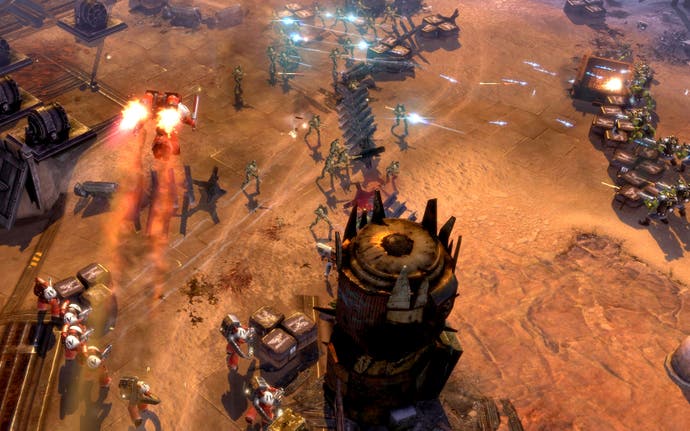
Relic says it wants to reward the player, and the rewards come thick and fast. Here the team takes its cue from MMOs. "In massives you get rewarded every 10 minutes," notes Ebbert. "Reward, bam, good job. Somebody's either telling you 'awesome job!', or they're giving you something. So we integrated that into our game." The first notable reward comes right after the short and sweet first mission. Beginning on the planet Caldius, a recruiting colony for Blood Ravens, player forces are tasked with repelling the Ork enemy, driving the filthy, gurning cowards back into a mineshaft and destroying the entrance. Thanks to our stunning heroics we get an improved chainsword and begin to power up our forces. Yippee!
Persistence is essential to the attachment Relic wants us to feel for our squads. The squads you start the game with, you'll finish it with, so it helps if you care. Mercifully, despite what Relic staff do in their spare time, bonding in-game doesn't require 20 pints of Stella and rolling around in the street with a bouncer. Instead it comes through gradually upgrading abilities, like health and melee skills, in-between missions with currency that has been accrued. So the characters not only develop through the narrative (and nifty CGI cut-scenes add a lot here), they also grow in stature according to the way you play the game. And Relic is keen to add that the story itself is not strictly linear: you will have a degree of choice of which missions you choose and where you go in the campaign.
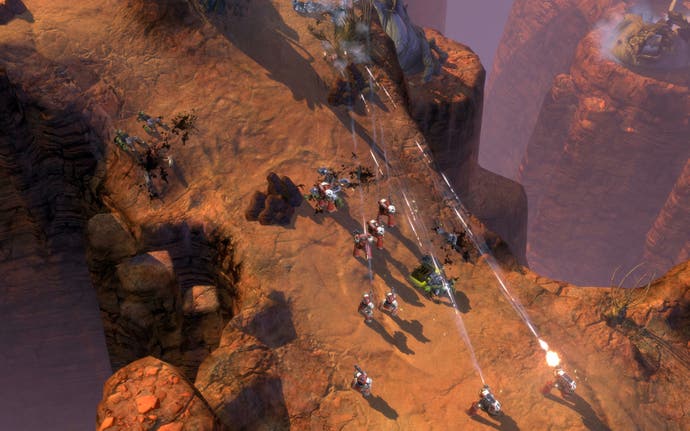
In certain missions there are also Stratagems that can be captured. Secure and reinforce these (your enemies will try to seize them back), and they can be used as healing points as well as dispensing items. There's something called 'Blessing of Fortitude' in the second mission, for examples, which offers 15 seconds of invulnerability to all units - rather handy in boss battles.
Early missions, bosses aside, begin fairly low-key, spacing out the enemy onslaught as you make yourself comfortable at your command deck. But by the end of the demo, your squads are dug around the walls of a capital building, flanked by numerous AI units, defending it against a multi-faceted Ork onslaught. It's like a mini Battle of Helm's Deep, intense, dramatic and very easy on the eyes. Dawn of War II ditches the old engine and uses the one that powered Company of Heroes. And it shows. The dark fantasy of 40k is recreated in fine detail. Individual unit animations are bursting with personality; and the sense of being caught up in brutal combat is heightened by the incessant chattering and screaming from your own squads and foes, over the general cacophony of war. Each of the bosses we encounter has several mouthfuls of deliciously dry abuse they taunt you with, which only adds to your desire to shred them into a thousand tiny cubes of singed flesh.

